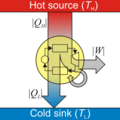Heat engine facts for kids
A heat engine is a special machine that turns heat energy into useful work. Think of it like this: it uses the difference in temperature between a hot place (called the "source") and a cold place (called the "sink"). Heat moves from the hot source, through the engine's working parts (like a gas or liquid), to the cold sink. As the heat moves, some of it changes into mechanical work.
There are many types of heat engines. Each one follows a specific process called a thermodynamic cycle. Sometimes, heat engines are named after these cycles, like the Carnot cycle. But they also have common names you might know, such as gasoline engines, turbines, or steam engines.
Some heat engines, like Internal combustion engines, create heat right inside the engine itself. Other heat engines get their heat from outside sources. Heat engines can also be "open" to the air or "closed" and sealed off from the outside.
Contents
How Heat Engines Work
Scientists often imagine "ideal" heat engines that are perfect and can't actually be built. These are called ideal cycles. Real heat engines try to copy these ideal ideas. When we talk about the actual machine, we usually say "engine." When we talk about the perfect idea, we say "cycle."
These simple models help us understand how engines work, even if real engines aren't quite perfect.
A key idea for heat engines is that the bigger the temperature difference between the hot source and the cold sink, the more efficient the engine can be. On Earth, the cold side of any heat engine is usually limited by the temperature of the air around it.
Engineers try to make heat engines more efficient by making the hot source even hotter. But if it gets too hot, the metal parts of the engine can start to melt or get soft!
Engine Efficiency Examples
The efficiency of a heat engine tells us how much of the heat energy it turns into useful work, instead of wasting it. Here are some examples:
- The OTEC idea, which uses the small temperature difference between warm surface ocean water and cold deep ocean water, is only about 3% efficient. This means 97% of the heat is wasted.
- Most car engines (gasoline/petrol engines) are about 25% efficient.
- Modern coal plants can reach about 45% efficiency.
- The most efficient engines, like a steam-cooled combined cycle gas turbine, can be around 60% efficient. These burn natural gas to heat air to very high temperatures (over 1500 degrees Celsius), creating a huge temperature difference.
Everyday Heat Engines
Many heat engines you see every day get their heat from a fire. This heat makes a working fluid (like water or air) expand. The cold sink is usually a body of water or the air around us, often with a cooling tower.
Familiar engines that use expanding hot gases include:
- The steam engine, which uses steam.
- The diesel engine.
- The gasoline (petrol) engine found in a car.
The Stirling engine is less common but can be found in small models. Some can even run just from the heat of your hand!
A fun toy that acts like a simple heat engine is the drinking bird.
A bimetallic strip is another interesting device. It changes temperature into movement and is used in thermostats to control heating or cooling. It's a heat engine that doesn't use a liquid or gas.
Related pages
Images for kids
See also
 In Spanish: Motor térmico para niños
In Spanish: Motor térmico para niños



